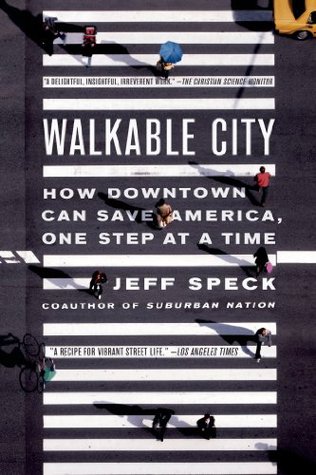More on this book
Community
Kindle Notes & Highlights
In the small and midsized cities where most Americans spend their lives, the daily decisions of local officials are still, more often than not, making their lives worse. This is not bad planning but the absence of planning, or rather, decision-making disconnected from planning.
Walkability is both an end and a means, as well as a measure. While the physical and social rewards of walking are many, walkability is perhaps most useful as it contributes to urban vitality and most meaningful as an indicator of that vitality.
In the absence of any larger vision or mandate, city engineers—worshiping the twin gods of Smooth Traffic and Ample Parking—have turned our downtowns into places that are easy to get to but not worth arriving at.
The General Theory of Walkability explains how, to be favored, a walk has to satisfy four main conditions: it must be useful, safe, comfortable, and interesting.
Useful means that most aspects of daily life are located close at hand and organized in a way that walking serves them well.
Safe means that the street has been designed to give pedestrians a fighting chance against being hit by automobiles; they must not only be safe but fe...
This highlight has been truncated due to consecutive passage length restrictions.
Comfortable means that buildings and landscape shape urban streets into “outdoor living rooms,” in contrast to wide-open spaces, whic...
This highlight has been truncated due to consecutive passage length restrictions.
Interesting means that sidewalks are lined by unique buildings with friendly faces and tha...
This highlight has been truncated due to consecutive passage length restrictions.
The modern world is full of experts who are paid to ignore criteria beyond their professions.
Almost 85 percent of money expended on cars and gas leaves the local economy
The conventional wisdom used to be that creating a strong economy came first, and that increased population and a higher quality of life would follow. The converse now seems more likely: creating a higher quality of life is the first step to attracting new residents and jobs.
A Belgian paper published in The Lancet found that traffic exposure accounts for more heart attacks worldwide than any other activity, even including physical exertion.
The real problem with cars is not that they don’t get enough miles per gallon; it’s that they make it too easy for people to spread out, encouraging forms of development that are inherently wasteful and damaging.…
the obsession with “sustainable” products that often have a statistically insignificant impact on the carbon footprint when compared to our location.
Unfortunately, as the transportation planner Dan Malouff puts it, “LEED architecture without good urban design is like cutting down the rainforest using hybrid-powered bulldozers.”
even they must understand the value of moving under one’s own power at a relaxed pace through a public sphere that continuously rewards the senses.
Lewis Mumford declared that “our national flower is the concrete cloverleaf,”
The computer model is only as good as its inputs, and there’s nothing easier than tweaking the inputs to get the outcome you want.
the most commonly tweaked input is anticipated background growth, which typically needs tweaking anyway: most cities’ traffic models presume 1 to 2 percent annual growth, even when those cities are shrinking.
As long as engineers are in charge of traffic studies, they will predict the need for engineering.
Induced demand is the name for what happens when increasing the supply of roadways lowers the time cost of driving, causing more people to drive and obliterating any reductions in congestion.
In Great Britain, where planners are no longer allowed to justify new highways on the basis of reduced congestion, road construction has dropped so drastically that Alarm UK, the main freeway protest organization, disbanded itself “on the grounds that it was no longer needed.”15
One wonders at the docility of the students who evidently must be satisfied enough with the credentials to be uncaring about the lack of education.
It would seem that only one thing is more destructive to the health of our downtowns than welcoming cars unconditionally and that is getting rid of them entirely. The proper response to obesity is not to stop eating, and most stores need car traffic to survive. With autos reintroduced, most failed pedestrian malls, like Monroe Place in Grand Rapids, have come back at least partway. The key is to welcome cars in the proper number and at the proper speed.
Inclusionary zoning—requiring a set percentage of all new housing developments to meet affordability criteria—


